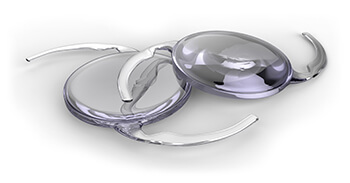Choosing an Artificial Lens

During cataract surgery, your doctor replaces the cloudy lens of your eye with an artificial lens, called an intraocular lens (IOL).
At Lyons Eye, we offer the most advanced intraocular lens implants. Today’s IOL technology can give you better vision than before cataract surgery, – often without glasses. With some IOLs, some people never need glasses after cataract surgery or only wear them occasionally.
Which lens should I choose?
You can choose from several types of IOLs with cataract surgery. You can read about these choices below. It can be complicated to choose the right lens. Before you choose, it is important to make sure you understand our options thoroughly.
You have 4 main lens types to choose from.:
- Standard IOL
- Toric IOL – corrects astigmatism
- Multifocal IOL —corrects for near and far
- Extended depth of focus IOL (Symfony) – corrects for intermediate distance and far
The multifocal and extended depth of focus IOLs are designed to correct presbyopia. These types of lenses make you less dependent on glasses to see objects nearby and far away. However, there are no guarantees that choosing one of these lenses will mean you no longer need glasses. You might still need some type of glasses, because there is no perfect lens technology available.
Learn more below about each type of lens. Insurance pays for standard lenses, but not the toric, multifocal, or Symfony IOLs . Your surgery scheduler can tell you what these other lens options cost.
Standard IOL
A standard IOL, also called a “monofocal” or “single focus” lens gives you very good clarity of vision. It is the most common IOL chosen. Insurance companies cover the cost of a standard IOL. You may choose 1 of 3 options:
Correcting both eyes to see well at a distance (objects far away)
Correcting both eyes to see well close- up (objects nearby)
Monovision – Correcting 1 eye to see well at a distance and 1 eye to see well close-up
Read more about these 3 options:
Toric IOL
A toric IOL corrects for astigmatism. Astigmatism simply means that the front part of your eye, the cornea, is not perfectly round. It is very common, and for most people is not a sign of anything serious. Contact lenses or glasses usually correct astigmatism. A toric IOL will correct moderate astigmatism with cataract surgery. This option can reduce your need for glasses after your surgery. If you choose a standard lens that does not correct astigmatism, you can wear glasses to correct it.
If you have moderate astigmatism and want better vision when you are NOT wearing glasses, you might want to consider the toric IOL . Insurance does not pay for this type of lens; your surgery scheduler can tell you the cost.
Multifocal IOL
A “multifocal” lens has 2 focus points. One is far away and one is near. There are many pros and cons to these types of lenses. You should only consider them if your eyes are completely healthy other than the cataracts.
Adjusting to these types of lenses can take time, sometimes months. You might see glare, like a “starburst” effect. You might also see halos, less contrast between objects, or see colors less well. Unfortunately, there are no guarantees that this type of lens will eliminate your need for glasses. You might still need glasses sometimes, because there is no perfect lens technology available.
Extended Depth of Focus IOL (Symfony)
The Tecnis Symfony IOL was released in 2016, the latest innovation in IOL technology. It is also available as a toric IOL, correcting for astigmatism. With this IOL, you can have high quality vision continuously from far distance up to medium distances. You will need glasses less, but you will still need them for near vision (small print). Some “star-burst” effects can happen with this lens, but it is not severe for most people and is less than with the multifocal IOLs.
This lens might not be appropriate for everyone. It is important to have a thorough exam and discussion with your doctor about any conditions you have that could affect your ability to use this lens.
Dr Lyons evaluates your eyes thoroughly before recommending an IOL. We’ll also talk about your work, hobbies and other activities to make sure your IOL fits your lifestyle. Because your eyes are so important for everything you do, selecting an IOL is a very personal decision. At Lyons Eye we will help you consider all your options.
Talk to us about whether cataract surgery is right for you, and what some of the risks may include. Get ready for brighter days ahead!
If you have symptoms of cataracts or another eye condition, we invite you to make an appointment today.
